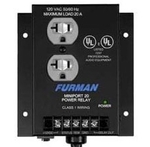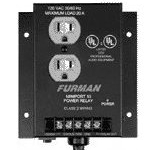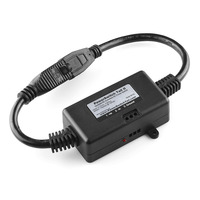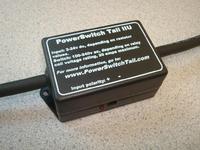This article is a follow up to Floodstop - Washing Machine
Furman MP-20 / MP-15
The original Floodstop - Washing Machine post suggested the use of the Furman MP-20 or Furman MP-20 to disconnect electric power from your washing machine in the case that the Floodstop detects water on its sensor pad.
However, I have received a number of feedback comments asking about alternatives to the Furman. The Furman devices are only available in 120V with US style connectors and they are somewhat costly. This article will attempt to provide a couple of alternatives and a D.I.Y. approach for those who are comfortable with a soldering iron and simple circuits. These alternatives are targeted at a lower cost solutions and at higher voltage solutions such as European 220-240VAC systems.
Option 1 - PowerSwitch Tail II (US 120VAC @ 15A)
The PowerSwitch Tail II is a simple inline power controller that can switch the high voltage 120VAC power using a separate and isolated low voltage 3-12 VDC source. This device is attractively priced in the ~$25 USD range.
This option is only viable in installations that use the US style plug and only require 120V and a maximum load of 15 amps. (Thus this option is a direct replacement for the Furman MP-15.)
The PowerSwitch Tail II is available via the following links:
To use this device with the Floodstop you will need a separate DC power source to power the low-voltage IO circuit between the Floodstop and PowerSwitch Tail II. Any low voltage DC power supply between 3-12 volts should work fine. Here are a few options available on SparkFun.com:
- Wall Adapter Power Supply - 5VDC 1A
- Wall Adapter Power Supply - 9VDC 650mA
- Wall Adapter Power Supply - 12VDC 600mA
(The type of barrel connector on the power supply does not matter as you will end up cutting off the barrel jack and stipping the insulation to the bare wire to connect to the Floodstop and PowerSwitch Tail II.)
Unlike the Furman configuration, this configuration will use the NC (normally-closed) pins on the Floodstop unit. When no water leak is detected by the Floodstop, the NC pins on the Floodstop will allow current to pass thru from the low voltage power supply to the PowerSwitch Tail II. This in turns engages the relay inside the PowerSwitch Tail II allowing the high-voltage circuit to power the washing machine plugged into the PowerSwitch Tail II. When the Floodstop detects a water leak, then the NC circuit inside the Floodstop unit becomes "opened" and no control current is allowed to pass through to the PowerSwitch Tail II, thus the relay inside the PowerSwitch Tail II is disenganged and the high-voltage circuit to the washing machine is switched off.
The wiring diagram below illustrates the low voltage circuit needed to drive the PowerSwitch Tail II from the Floodstop unit.
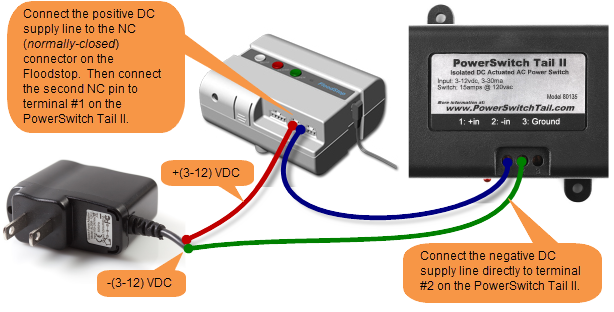 Low-voltage (IO) Control Circuit
Low-voltage (IO) Control Circuit
Below is a schematic of the PowerSwitch Tail II and it's specifications:
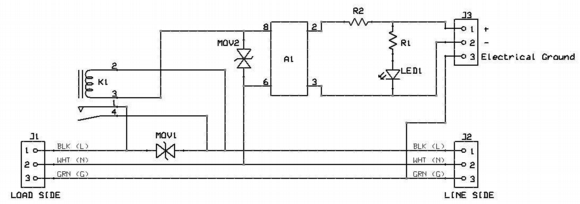
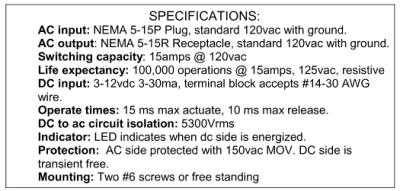
>> Instructions Manual for PowerSwitch Tail II
Option 2 - PowerSwitch Tail IIU-120/240 (110-120VAC @ 20A / 200-240VAC @ 20A)
The PowerSwitch Tail IIU is a power controller kit that can switch higher voltages and higher current loads than that of the standard PowerSwitch Tail II unit described above. This option is viable in installations that require voltages up to 240VAC and a maximum load of 20 amps. (Thus this option is a replacement for the Furman MP-20.)
There are two distinct models to choose from based on the voltage requirements that you require.
- PowerSwitch Tail IIU-120 Kit (110-120VAC @ 20A) - USA
- PowerSwitch Tail IIU-240 Kit (200-240VAC @ 20A) - Europe
This is a D.I.Y. kit that will require the ability to follow a simple schematic and solder components to a circuit board. Please see the following instructions to determine the skills necessary to assemble this kit.
>> Instructions Manual for PowerSwitch Tail IIU
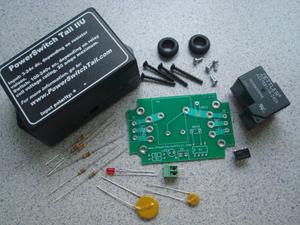 PowerSwitch Tail IIU (Kit)
PowerSwitch Tail IIU (Kit)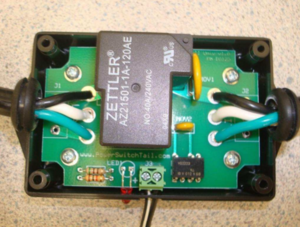 PowerSwitch Tail IIU (Assembled)
PowerSwitch Tail IIU (Assembled)
This kit is attractively priced in the ~$18 USD range but it should be noted that additional supplies are required to build a fully functioning power controller. You must provide your own AC plug connectors for your specific application. Below is an example of a fully assembled unit with US and European style plugs. The best option for the washing machine application may be to buy a short extension cord property rated for voltage and amperage required and to cut off both ends and use the ends to solder directly to this board. Cut the extension cord ends with enough length on each end to meet your installation needs, but avoid leaving unnecessary and excessive lengths of cord as this will result in additional resistance in the high-voltage circuit.
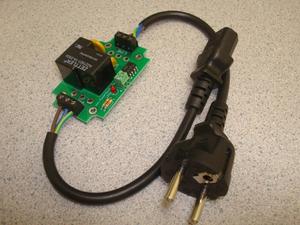 PowerSwitch Tail IIU (with European plug)
PowerSwitch Tail IIU (with European plug)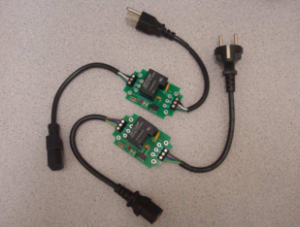 PowerSwitch Tail IIU (US & European plugs)
PowerSwitch Tail IIU (US & European plugs)
To use this device with the Floodstop you will need a separate DC power source to power the low-voltage IO circuit between the Floodstop and PowerSwitch Tail IIU. Any low voltage DC power supply between 3-24 volts should work fine. Please see the PowerSwitch Tail IIU instructions to install the correct resistors based on the supply voltage. Here are a few options available on SparkFun.com:
- Wall Adapter Power Supply - 5VDC 1A
- Wall Adapter Power Supply - 9VDC 650mA
- Wall Adapter Power Supply - 12VDC 600mA
(The type of barrel connector on the power supply does not matter as you will end up cutting off the barrel jack and stipping the insulation to the bare wire to connect to the Floodstop and PowerSwitch Tail IIU.)
Unlike the Furman configuration, this configuration will use the NC (normally-closed) pins on the Floodstop unit. When no water leak is detected by the Floodstop, the NC pins on the Floodstop will allow current to pass thru from the low voltage power supply to the PowerSwitch Tail IIU. This in turns engages the relay inside the PowerSwitch Tail IIU allowing the high-voltage circuit to power the washing machine plugged into the PowerSwitch Tail IIU. When the Floodstop detects a water leak, then the NC circuit inside the Floodstop unit becomes "opened" and no control current is allowed to pass through to the PowerSwitch Tail IIU, thus the relay inside the PowerSwitch Tail IIU is disenganged and the high-voltage circuit to the washing machine is switched off.
The wiring diagram below illustrates the low voltage circuit needed to drive the PowerSwitch Tail IIU from the Floodstop unit.
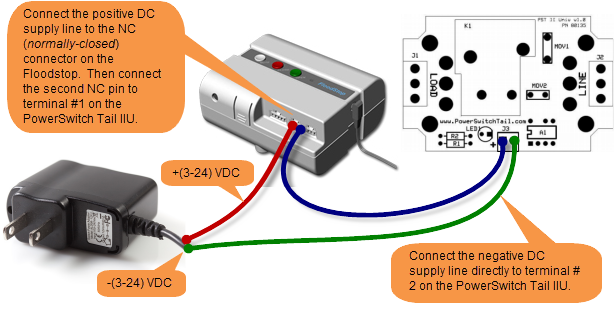 Low-voltage (IO) Control Circuit
Low-voltage (IO) Control Circuit
Below is a schematic of the PowerSwitch Tail IIU:
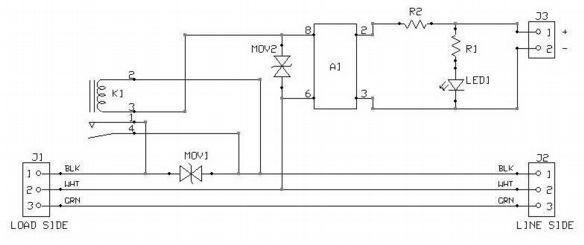
Option 3 - Build Your Own Power Controller Circuit
Building your own simple power controller circuit is relatively simple. Using the two devices above as examples, you can purchase your own relay and other components and build a power controller.
The design should take care to provide isolation between the low-voltage "control" circuit, the magnetic coil and the high-voltage "load" circuit. The PowerSwitch Tail designs use an opto-isolated solid state relay to accept a low-voltage control signal and use it to drive the high-voltage magnetic coil of the relay. This completelty isolates the low-voltage control circuit from the high-voltage coil circuit and high-voltage load circuit.
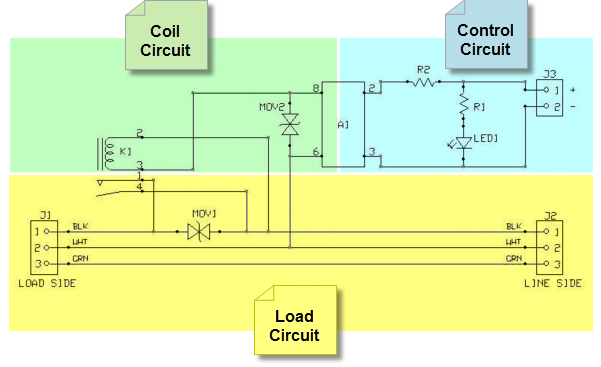
Your design should also consider magnetic coil flyback using a coil suppression technique. More information on coil supression can be found here. The PowerSwitch Tail designs use metal oxide varistors to address coil suppression.
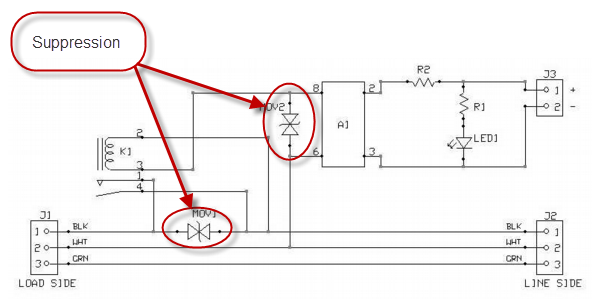
Unlike the PowerSwitch Tail designs you may prefer your power controller circuit to use a NO (normally-open) control circuit to control when the load circuit is powered ON. If you use a SPDT relay, you should be able to use the NO (normally-open) ouput lead of the relay for your load circuit instead of the NC (normally-closed) lead. The reason for using a NO control circuit is because in the washing machine application the power should be flowing to the load circuit almost 100% of the time. Thus it makes more sense that the while the relay is a "REST" you want the load circuitr to be ON. Only in the rare cases where the Floodstop detects a water leak do you want the relay to be engaged and power to be disrupted to the load circuit and thus powering off the washing machine.
Although it is not recommended to use this device as is due to safety concerns and insufficient load capacity, here is one additional design example you can use as a reference:
This example uses a transistor instead of an opto-isolated solid state relay to accept the control voltage and drive a low-voltage coil relay. This example uses a couple of diodes instead of varistors for coil suppression.
Disclaimer
I have not personally tested each of these power controllers independantly or with the Floodstop controller. I have included these devices and examples here to help others find workable solutions for their sitations where the Furman is not a viable option. I have documented the information and wiring diagrams to the best of my ability based on the available product documentation for each of the devices. If you find an error in the content, please let me know so that I may make any necessary corrections.
Safety-First. Make sure to use caution and the appropriate safety measures while working with high-voltage AC power. If you are not confortable or experienced working with AC voltage, please consult an electrician or experienced preofessional. Additional disclaimer information is listed here.
